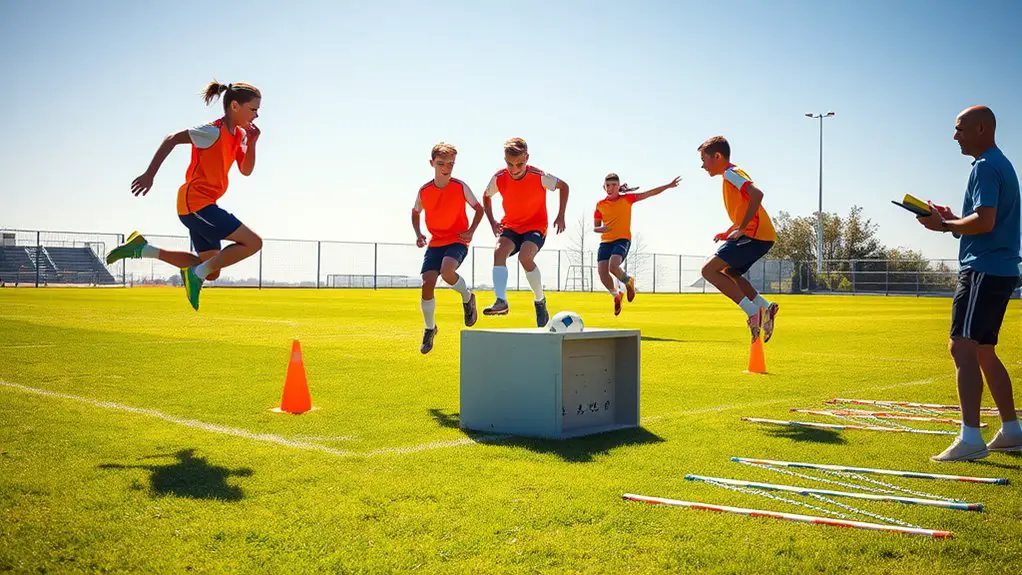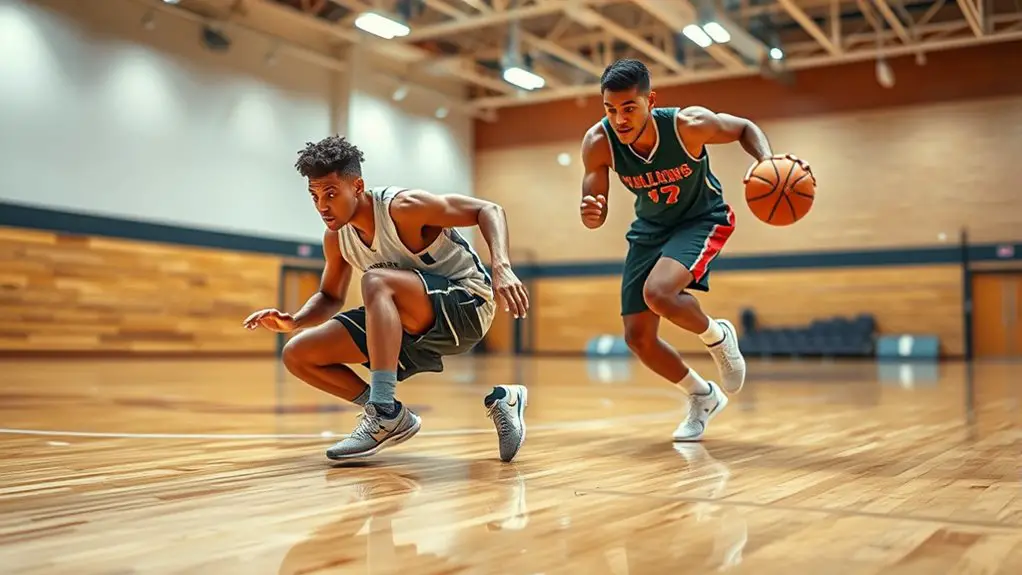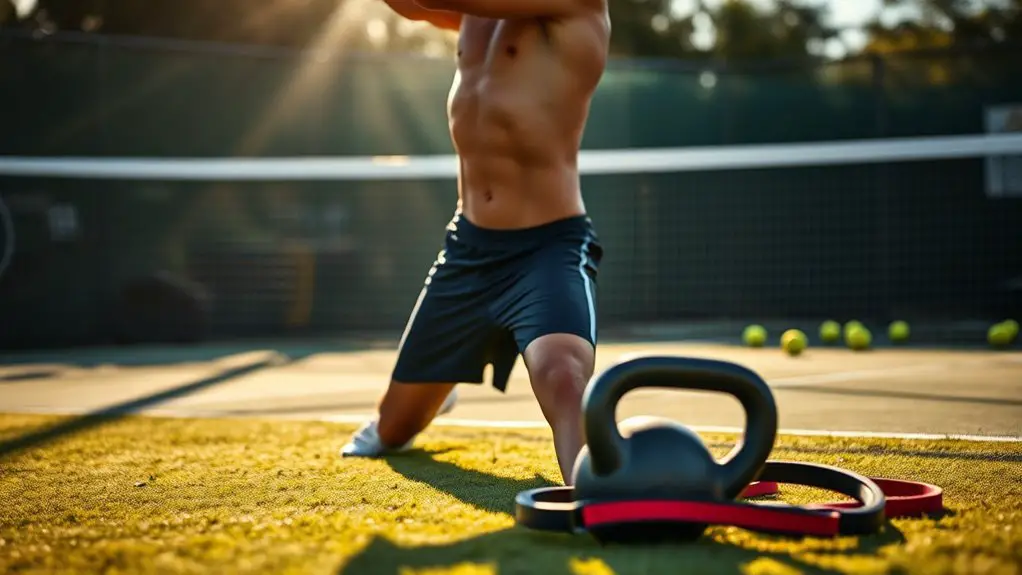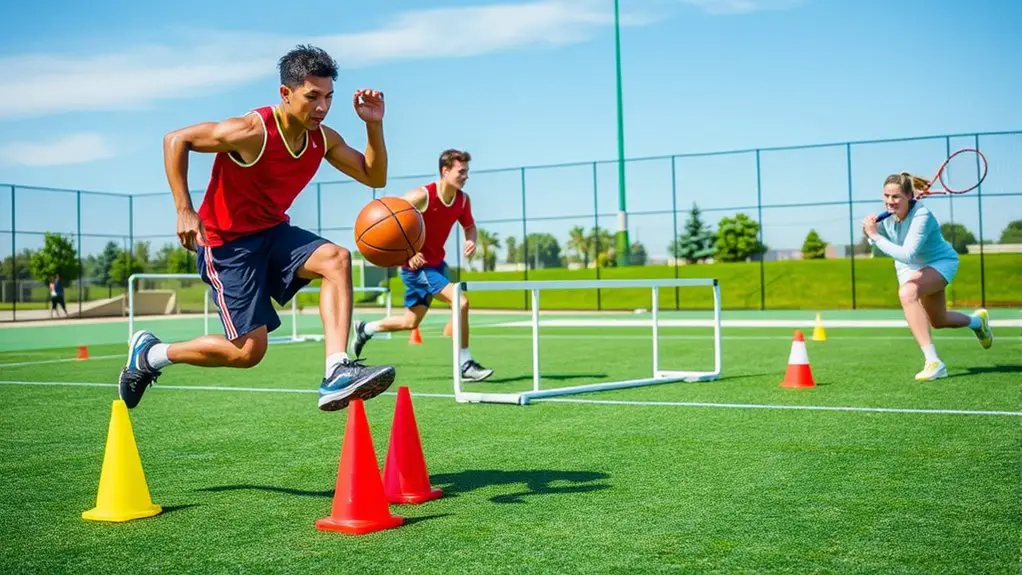To boost your soccer agility, incorporate plyometric drills like box jumps, lateral bounds, and tuck jumps. Box jumps build explosive power, while lateral bounds enhance your side-to-side movement for quick evasion. Tuck jumps improve your vertical leap for winning headers, and depth jumps develop your reaction time. Don't forget single-leg hops for balance and strength, along with agility ladder drills for foot speed. There's more to discover about maximizing your training routine for peak performance.
Understanding Plyometric Training in Soccer
When you think about improving your agility on the soccer field, plyometric training is a game-changer. It's not just about running faster; it's about mastering plyometric fundamentals that enhance your soccer performance. These explosive movements, like jumps and bounds, help develop the power and coordination essential for quick direction changes and bursts of speed. Incorporating fast-twitch muscle fibers into your training can significantly boost your overall athletic performance.
Importance of Agility for Soccer Players
Agility plays a pivotal role in a soccer player's performance on the field. It enables you to change direction quickly, evade opponents, and maintain balance while on the move. Mastering agility drills and footwork techniques can elevate your game, giving you the freedom to express your skills and creativity during matches. Additionally, strength training is crucial for enhancing muscle power, which supports effective directional changes.
| Benefit | Description |
|---|---|
| Quick Direction Change | Helps you dodge defenders and find space. |
| Improved Balance | Enhances stability during dynamic movements. |
| Enhanced Reaction Time | Allows quicker responses to game situations. |
Box Jumps for Explosive Power
Box jumps are a powerful way to boost your explosive strength, which is essential for soccer performance. By incorporating box jump variations into your routine, you can enhance your ability to spring off the ground quickly, giving you an edge on the field. Start with a basic jump to a stable box, focusing on landing softly and maintaining good form. As you progress, try different heights or even lateral jumps to challenge your muscles further.
Explosive power training with box jumps not only builds strength but also improves your coordination and balance, vital for those quick maneuvers during a game. Remember to warm up properly to prevent injury and allow your body to adapt. With consistent practice, you'll notice increased agility and speed, empowering you to move freely and confidently in every match. Additionally, focusing on proper technique during these drills will maximize your explosive power and minimize the risk of injury. Embrace this dynamic exercise, and watch your soccer skills soar!
Lateral Bounds to Enhance Side-to-Side Movement
Although soccer often requires forward and backward movement, the ability to shift swiftly from side to side is equally essential for effective gameplay. Lateral bounds are a fantastic way to enhance your lateral movement and gain that edge on the field. This plyometric drill focuses on explosive side-to-side jumps, helping you develop the strength and agility needed to outmaneuver your opponents.
To perform lateral bounds, start by standing on one leg, then push off explosively to the side, landing on the opposite leg. Make sure you maintain balance as you absorb the impact. Repeat this motion, alternating sides, to build muscle memory and improve your coordination. Proper footwork reduces the risk of injuries, making these bounds not only beneficial for performance but also crucial for your safety on the pitch.
Incorporating these bounds into your training routine can provide significant plyometric benefits, increasing your speed and responsiveness. So, let loose and make those lateral movements your secret weapon, giving you the freedom to dominate the pitch!
Tuck Jumps for Increased Vertical Leap
Tuck jumps are a fantastic way to boost your vertical leap, which is vital for winning headers and making explosive plays on the field. By mastering the proper technique, you can maximize the benefits and integrate these jumps into your training sessions effectively. Let's break down how to perform them correctly and why they're important for soccer players like you. Additionally, incorporating plyometric exercises like tuck jumps can enhance your overall explosiveness and agility on the field.
Proper Tuck Jump Technique
To master the tuck jump technique, you'll want to focus on three key elements: explosive power, proper form, and controlled landing. This will help you reap the plyometric benefits, enhancing your vertical leap and overall agility. Here's a quick reference table to guide you:
| Key Element | Description | Tips |
|---|---|---|
| Explosive Power | Generate maximum force from your legs | Use your arms for momentum |
| Proper Form | Keep your knees up and back straight | Engage your core |
| Controlled Landing | Land softly to prevent injury | Bend your knees slightly |
Benefits for Soccer Players
Mastering the tuck jump technique not only improves your explosive power and form but also offers significant benefits for soccer players. By incorporating this plyometric drill into your routine, you'll experience performance enhancement that translates directly to the field. Increased vertical leap allows you to outjump opponents during headers, giving you that edge when it counts. Plus, the dynamic nature of tuck jumps strengthens your muscles and joints, contributing to injury prevention. You'll build resilience against common soccer injuries, keeping you on the pitch longer. Embracing this drill means you're investing in your athletic freedom—enhancing your game while reducing the risk of setbacks. So, jump into those tuck jumps and watch your performance soar!
Incorporating Into Training Sessions
When you're looking to boost your vertical leap, incorporating tuck jumps into your training sessions can make a significant difference. Start with basic plyometric progressions to build strength and confidence. You might want to add tuck jumps after your warm-up or within a circuit to keep your heart rate up. Aim for two to three sessions per week, adjusting your training frequency based on how your body feels. As you get comfortable, increase the number of repetitions or the height of your jumps. Remember, quality matters more than quantity; focus on form to maximize benefits. By consistently integrating these jumps, you'll not only enhance your vertical leap but also elevate your overall agility on the field.
Depth Jumps for Reaction Time Improvement
Depth jumps can greatly enhance your reaction time on the field, giving you an edge during play. To reap the benefits, it's crucial to follow proper technique guidelines to guarantee safety and effectiveness. Let's explore how mastering these jumps can improve your agility and performance in soccer. Additionally, incorporating agility ladder drills into your training routine can further boost your foot speed and coordination, complementing the benefits gained from depth jumps.
Benefits of Depth Jumps
Incorporating depth jumps into your training routine can markedly enhance your reaction time, an essential aspect of soccer agility. These explosive movements not only increase power but also improve your ability to respond quickly to game situations. The depth jump benefits extend beyond just your physical capabilities; they also help you develop mental sharpness.
| Depth Jump Benefits | Impact on Soccer |
|---|---|
| Increases explosiveness | Quicker sprints and changes of direction |
| Enhances reaction time | Better responsiveness to opponents |
| Improves muscle coordination | Greater control over movements |
| Builds confidence | Feeling empowered on the field |
With consistent plyometric training, you'll elevate your overall performance and enjoy the freedom to play your best game.
Proper Technique Guidelines
To maximize the benefits of depth jumps for improving reaction time, it's crucial to focus on proper technique. Start by ensuring your jumping mechanics are sound; stand on a stable platform, step off, and aim to land softly. As you descend, keep your core engaged and your knees slightly bent to absorb the impact. This promotes landing safety and reduces injury risk. Avoid landing flat-footed; instead, use the balls of your feet to cushion your landing, which enhances your body's responsiveness. Practice quickly rebounding off the ground to train your muscles for explosive power. Remember, consistency is key. By honing your technique, you'll not only boost your agility but also feel the freedom of movement on the field.
Single-Leg Hops for Balance and Strength
While mastering agility on the soccer field, single-leg hops can greatly enhance your balance and strength. These dynamic movements are perfect for athletes seeking freedom in their gameplay. By incorporating single-leg hops into your routine, you're not just jumping; you're engaging in effective balance training that challenges your stability.
Start by hopping on one leg, focusing on landing softly and maintaining control. As you improve, increase the height and distance of your hops for strength building. This drill not only fortifies your legs but also sharpens your proprioception, allowing you to react swiftly during a match. Additionally, enhancing your core strength will support your overall balance and stability during these hops.
To maximize benefits, alternate legs and aim for a series of hops in quick succession. You'll quickly notice how this simple exercise transforms your ability to pivot, sprint, and evade opponents. Embrace the freedom these hops bring, and watch your agility soar on the field!
Agility Ladder Drills for Foot Speed
Agility ladder drills are a fantastic way to boost your foot speed and coordination on the soccer field. These drills offer a fun and dynamic way to enhance your game, giving you the freedom to explore various ladder variations. Start with basic footwork patterns like the two-foot run, then progress to more complex moves like lateral shuffles or in-and-out steps.
As you become comfortable, try mixing up the patterns to challenge yourself and keep the training fresh. The key is to maintain quick, light feet while staying balanced and controlled. Remember, the more you practice, the more natural these movements will feel during a match.
Incorporating agility ladder drills into your routine not only improves your speed but also sharpens your overall agility, helping you dodge defenders and maneuver seamlessly on the pitch. Additionally, these drills enhance quick directional changes, which is vital for effective movement in soccer. Embrace the challenge, and watch your game transform!
Incorporating Plyometrics Into Your Training Routine
Building on the improvements gained from agility ladder drills, incorporating plyometrics into your training routine can take your performance to the next level. Start with dynamic warm ups to prepare your muscles and joints, helping you maximize the benefits of each plyometric exercise. Think jump squats, box jumps, and lateral bounds, all designed to enhance your explosiveness and agility on the field. Incorporating plyometric exercises not only engages fast-twitch muscle fibers but also boosts your overall conditioning.
Aim for two to three plyometric sessions per week, ensuring you balance intensity with recovery techniques. Don't forget to listen to your body; rest is essential for preventing injuries and promoting strength gains. After your workouts, integrate active recovery methods like light jogging or stretching to keep your muscles limber. By embracing this combination of plyometrics and recovery, you'll not only boost your agility but also embrace a training routine that feels liberating and effective. Get ready to release your full potential!
Frequently Asked Questions
How Often Should I Incorporate Plyometrics Into My Training?
When it comes to plyometric frequency, you'll want to find a balance that fits your training schedule. Aim for two to three sessions per week, allowing adequate recovery between workouts. This way, you can maximize your explosiveness without overdoing it. Listen to your body; if you feel fatigued, don't hesitate to adjust. The goal is to enhance your agility while enjoying the freedom that comes with effective training. Keep it fun and dynamic!
Are Plyometric Drills Safe for Beginner Soccer Players?
Did you know that 70% of injuries in youth sports come from improper technique? For beginner soccer players, plyometric drills can be safe if you focus on proper technique. Start slow, ensuring you've got the basics down before diving into more intense exercises. Always listen to your body, and don't hesitate to scale back if something feels off. With the right approach, you can enjoy the freedom of movement while staying safe!
What Is the Best Time of Day for Plyometric Training?
When it comes to the best time for plyometric training, it really depends on your schedule and energy levels. Morning workouts can energize your day, helping you feel more alert. On the other hand, evening sessions might fit better if you're a night owl. You'll want to choose a time that feels right for you, allowing for freedom in your routine. Listen to your body and find what works best to maximize your performance.
Can Plyometrics Help Prevent Soccer Injuries?
You might think plyometrics are just for performance, but they're also essential for injury prevention. When you incorporate plyometric exercises into your routine, you strengthen your muscles and improve your coordination, which helps reduce the risk of injuries on the field. The benefits of plyometrics extend beyond agility; they enhance your body's resilience. So, embrace these drills and enjoy the freedom of playing without the worry of getting hurt.
How Long Should Each Plyometric Session Last?
When it comes to session duration for plyometric training, you'll want to aim for about 30 to 60 minutes. This timeframe allows you to maintain high training intensity without overexerting yourself. You can incorporate various drills while ensuring you're not compromising form or safety. Remember, it's all about finding that balance—pushing your limits while enjoying the freedom of movement. Listen to your body, and adjust accordingly for best results.




